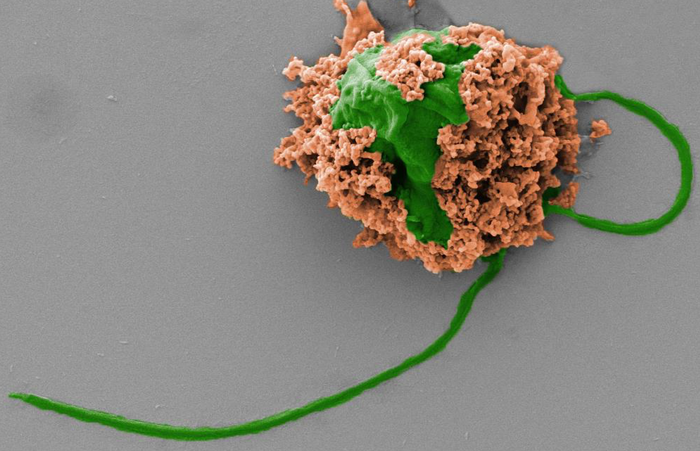Microscopic Robots in the Lungs Treat Bacterial Pneumonia in Mice - Genetic Engineering & Biotechnology News

The last decade has brought a lot of attention to the use of microscopic robots (microrobots or nanorobots) for biomedical applications. Now, nanoengineers have developed microrobots that can swim around in the lungs and deliver medication to be used to treat bacterial pneumonia. A new study shows that the microrobots safely eliminated pneumonia-causing bacteria in the lungs of mice and resulted in 100% survival. By contrast, untreated mice all died within three days after infection.
The results are published Nature Materials in the paper, "Nanoparticle-modified microrobots for in vivo antibiotic delivery to treat acute bacterial pneumonia."
The microrobots are made using click chemistry to attach antibiotic-loaded neutrophil membrane-coated polymeric nanoparticles to natural microalgae. The hybrid microrobots could be used for the active delivery of antibiotics in the lungs in vivo.
The algae provide movement, which allows the microrobots to swim around and deliver antibiotics directly to more bacteria in the lungs. The nanoparticles containing the antibiotics are made of tiny biodegradable polymer spheres that are coated with the cell membranes of neutrophils. These cell membranes absorb and neutralize inflammatory molecules produced by bacteria and the body's immune system. This gives the microrobots the ability to reduce harmful inflammation, which in turn makes them more effective at fighting lung infection.
"Our goal is to do targeted drug delivery into more challenging parts of the body, like the lungs. And we want to do it in a way that is safe, easy, biocompatible, and long lasting," said Liangfang Zhang, PhD, professor in the department of nanoengineering at the University of California, San Diego (UCSD), Jacobs School of Engineering. "That is what we've demonstrated in this work."
The microrobots are fast (>110 µm s−1) in simulated lung fluid and uniform distribution into deep lung tissues. The authors also noted that they "have low clearance by alveolar macrophages and superb tissue retention time (>2 days) after intratracheal administration to test animals."
The team used the microrobots to treat mice with an acute and potentially fatal form of pneumonia caused by Pseudomonas aeruginosa. This form of pneumonia commonly affects patients who receive mechanical ventilation in the intensive care unit. The researchers administered the microrobots to the lungs of the mice through a tube inserted in the windpipe. The infections fully cleared up after one week. All mice treated with the microrobots survived past 30 days, while untreated mice died within three days.
Treatment with the microrobots was more effective than an IV injection of antibiotics into the bloodstream. The latter required a dose of antibiotics that was 3000 times higher than that used in the microrobots to achieve the same effect. For comparison, a dose of microrobots provided 500 nanograms of antibiotics per mouse, while an IV injection provided 1.644 milligrams of antibiotics per mouse.
The team's approach is so effective because it puts the medication right where it needs to go rather than diffusing it through the rest of the body. "These results show how targeted drug delivery combined with active movement from the microalgae improves therapeutic efficacy," said Joseph Wang, PhD, professor in the department of nanoengineering, UCSD.
"With an IV injection, sometimes only a very small fraction of antibiotics will get into the lungs. That's why many current antibiotic treatments for pneumonia don't work as well as needed, leading to very high mortality rates in the sickest patients," said Victor Nizet, MD, professor at UCSD School of Medicine. "Based on these mouse data, we see that the microrobots could potentially improve antibiotic penetration to kill bacterial pathogens and save more patients' lives."
The work is still at the proof-of-concept stage. The team plans to do more basic research to understand exactly how the microrobots interact with the immune system. Next steps also include studies to validate the microrobot treatment and scaling it up before testing it in larger animals and eventually, in humans.
"We're pushing the boundary further in the field of targeted drug delivery," said Zhang.
Comments
Post a Comment